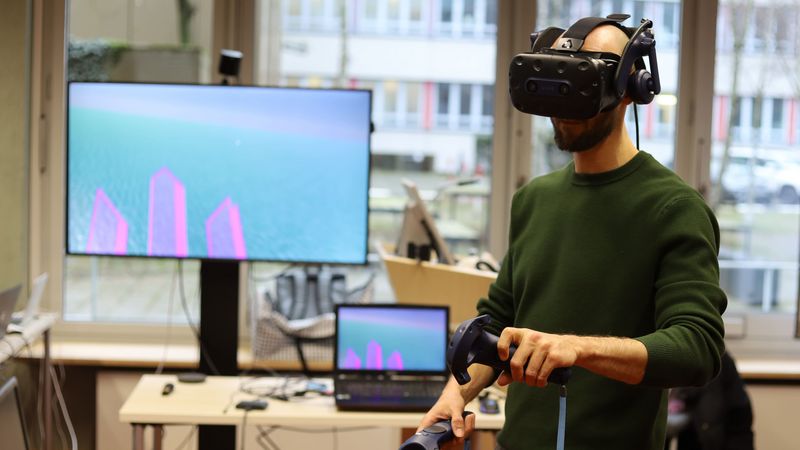In December 2023 , a week before Christmas, we could finally present another Art and Science collaboration project: a Virtual Reality (VR) Experience. On December 14, everyone interested had the chance to virtually try out what it is like to immerse up close in waves and weather. Virtual reality designer Lena Biresch therefore used the shallow water model and data from TRR181-researcher Silvano Rosenau and Nicolas Dettling to create the experience.
As an integral part of the TRR181, our ART&SCIENCE program aims at making the output of the research project more accessible to the public. In the past, we already collaborated with various artists to create two theatre plays presented in Hamburg, an „Encoding Seas“-Symphony in Berlin, other acoustic installations and a painting.
This time, VR-artist Lena Biresch created a digital experience, where the player moves in a virtually created ocean surrounding. In contrast to other forms of VR, like the Unreal Game Engine, this experience was designed as a Unity Game Engine. This means, that it is interactive for a single player and only the controlling person can see and hear the content from an Ego-perspective by using corresponding technical equipment, such as the glasses, headphones and joysticks. Once you put on the futuristic looking glasses, it quickly becomes clear that you immerse yourself in another world – Poseidon’s world!
While the bystanders can only see a glimpse of the virtual room on a screen, the actual player is set into an impressive 3D surrounding and during the experience learns to steer the waves and weather conditions – like the ancient Greek God of the sea and storms. You literally fall from the blue sky into water and sink to the bottom of the ocean. Next, you find yourself being able to swim through the vast ocean world with the joysticks in your hand. After reaching the surface, you can change the movements a little bit and fly back up to the sky. At this point, it all felt so real, that some of the participants became a little dizzy and started heading down to the surface of the ocean again to avoid altitude vertigo. But then the next phase of the experience sets in – and you start seeing an area on the surface of the ocean, where sharp waves are standing out; this is the part of the simulation, where original data from the TRR181 oceanographic research was used and where you can play around with the intensity of the weather conditions with a virtual tool modelled on Poseidon’s trident.
As only one person at a time was able to experience the virtual reality, the other participants had a welcome change from their daily work routine at the event. Almost 25 participants used the time to have a good chat and exchange with their colleges (not least about the admittedly entertaining sight of the VR-playing people) and enjoy the buffet and coffee.
All in all, it has been a wonderful and different visualization of ocean data, and an exciting experience that for sure will be offered to the public again in future events. Stay up to date!







